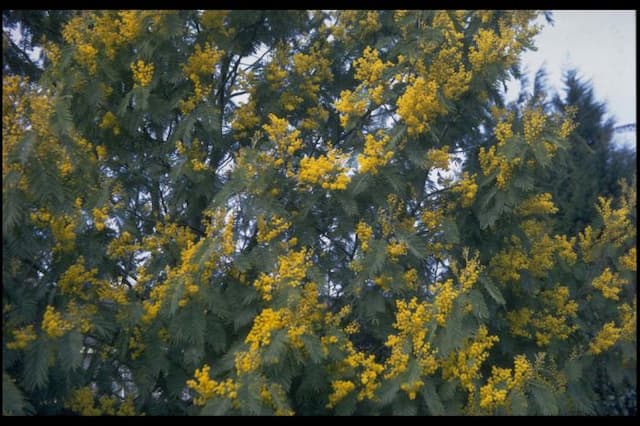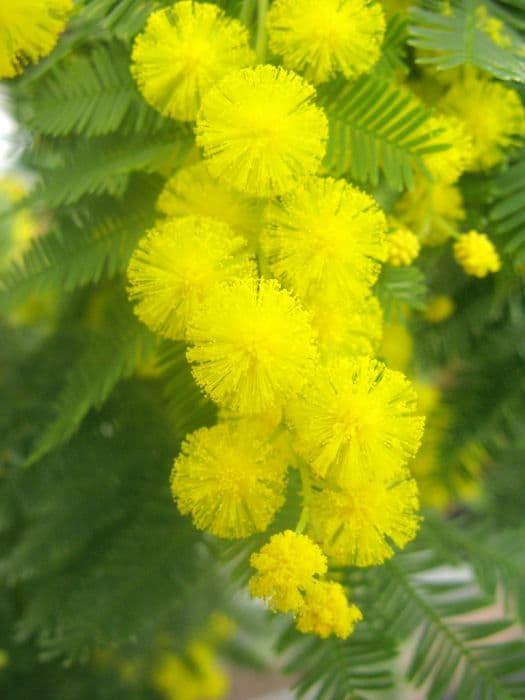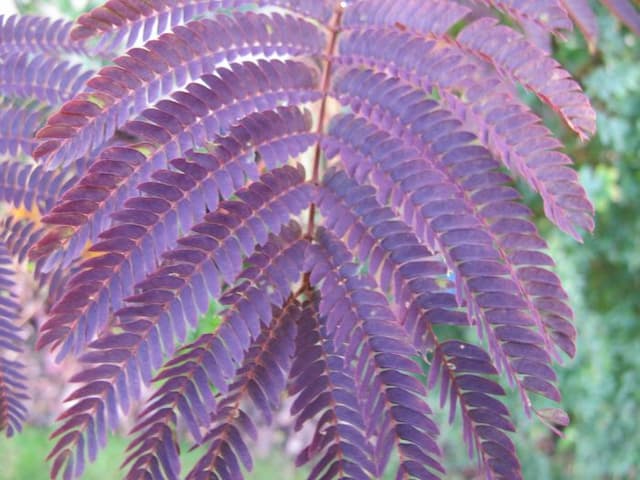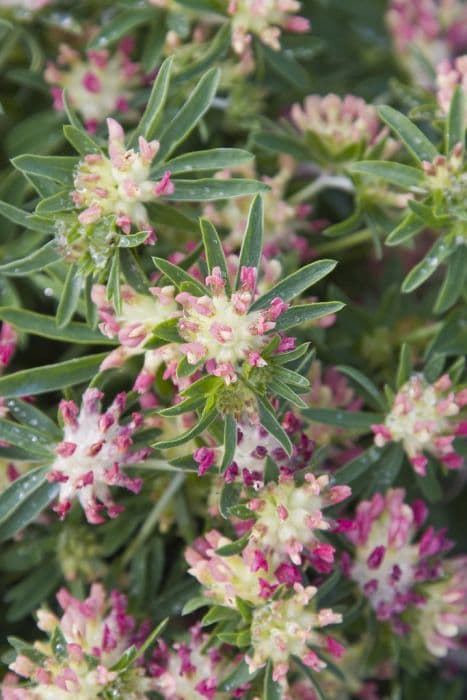Woodside Broom Carmichaelia glabrescens 'Woodside'

ABOUT
The 'Woodside' is a species of broom that's known for its unique and attractive appearance. This plant typically features slender, erect, and sometimes interwoven branches that give it a distinctive structure. Its leaves are small, scale-like, and often sparse, which contributes to an overall delicate and fine-textured look. The foliage usually presents in a blue-green or gray-green hue that can add a subtle splash of color to a garden setting. During the blooming season, the 'Woodside' broom produces small yet conspicuous flowers. These blossoms are usually a brilliant display of colors ranging from purple to violet, though some may appear almost blue, and they are typically arranged in loose clusters along the branches. The contrast between the blooms and the foliage is striking, making it an attractive plant during its flowering period. After the flowering season, seed pods may develop, which are generally small and may have a flattened appearance. These pods add an additional point of interest to the plant's overall look even after the flowers have faded. Overall, the 'Woodside' broom has a somewhat wiry and open growth habit, contributing to its airy and uncluttered appearance in a landscape where it often serves as an ornamental accent, known for both its foliage and its vibrant floral display.
About this plant
 Names
NamesFamily
Fabaceae
Synonyms
New Zealand Broom, Leafless Broom
Common names
Carmichaelia glabrescens 'Woodside'
 Toxicity
ToxicityTo humans
Information on the toxicity of New Zealand broom (Carmichaelia glabrescens 'Woodside') to humans is limited. If this particular variety has any toxic properties, they are not well-documented. However, as a general precaution, it is advisable not to ingest any part of ornamental plants as they may have compounds that can cause adverse effects. If a plant is known to be toxic, symptoms of plant poisoning can range from mild gastrointestinal discomfort to more severe reactions depending on the plant in question and the amount ingested.
To pets
There is limited specific information on the toxicity of New Zealand broom (Carmichaelia glabrescens 'Woodside') to pets. In the absence of clear data, it is prudent to prevent pets from ingesting parts of this plant. If a pet does consume part of a plant that is toxic, symptoms may include vomiting, diarrhea, lethargy, or more serious health issues depending on the toxicity of the plant and how much was ingested. Always keep an eye on your pets and prevent them from chewing on unknown plants, and consult a veterinarian if you suspect poisoning.
 Characteristics
CharacteristicsLife cycle
Perennials
Foliage type
Deciduous
Color of leaves
Green
Flower color
Varies
Height
6 feet (1.83 meters)
Spread
4 feet (1.22 meters)
Plant type
Shrub
Hardiness zones
8
Native area
New Zealand
Benefits
 General Benefits
General Benefits- Ornamental Appeal: Adds visual interest to gardens with its unique, spiky foliage and sculptural form.
- Drought Tolerance: Once established, it requires minimal water, making it an excellent choice for water-wise landscapes.
- Native Habitat Support: Being native to New Zealand, it provides food and habitat for local wildlife, such as birds and insects.
- Low Maintenance: Requires little pruning or care once established, making it ideal for gardeners seeking low-maintenance plants.
- Soil Adaptability: Can thrive in a range of soil types, though it prefers well-draining conditions.
- Wind Resistance: Its sturdy nature makes it resistant to damage from strong winds, suitable for exposed or coastal areas.
 Medical Properties
Medical PropertiesThis plant is not used for medical purposes.
 Air-purifying Qualities
Air-purifying QualitiesThis plant is not specifically known for air purifying qualities.
 Other Uses
Other Uses- Flower Arrangement: The stems and intricate flowers of the New Zealand broom make it a unique choice for adding structural interest to floral arrangements.
- Insect Habitat: The New Zealand broom can provide shelter and a nesting site for beneficial insects, such as native bees, which can help with the pollination of other garden plants.
- Erosion Control: With its ability to grow in poor soils, the New Zealand broom can be used on slopes or areas that are prone to soil erosion, helping to stabilize the ground.
- Garden Sculpture: New Zealand broom's distinct growth pattern can be pruned and trained into living garden sculptures, adding a creative touch to landscapes.
- Educational Use: This plant can be utilized in botanical gardens or educational programs to showcase the unique flora of New Zealand and promote conservation understanding.
- Wildlife Attraction: Birds may use the dense foliage of the New Zealand broom for cover or even as a food source if the plant hosts insects for them to eat.
- Windbreak: Due to its robust nature, New Zealand broom can be planted in rows to act as a windbreak, protecting more delicate plants and reducing wind erosion.
- Soil Improvement: As a legume, it's likely that the New Zealand broom can help to enrich the soil with nutrients, particularly nitrogen, through its root nodules.
- Photography Subject: The distinct look of the New Zealand broom's flowers and foliage can make it an interesting subject for nature photographers.
- Bonsai: With the appropriate care and pruning, the New Zealand broom can be cultivated as a bonsai, bringing a touch of New Zealand's natural beauty into the home.
Interesting Facts
 Feng Shui
Feng ShuiThe Carmichaelia is not used in Feng Shui practice.
 Zodiac Sign Compitability
Zodiac Sign CompitabilityThe Carmichaelia is not used in astrology practice.
 Plant Symbolism
Plant Symbolism- Resilience: Carmichaelia glabrescens 'Woodside', commonly known as the New Zealand broom, typically grows in harsh environments, symbolizing the ability to endure and adapt to challenging conditions.
- Adaptability: As a plant that can thrive in different soil types and climates, the New Zealand broom represents the capability to flourish under varied circumstances.
- Purity: The clean, straightforward growth of the plant, often unadorned with leaves, can signify purity and a focus on the essentials in life.
- Simplicity: The sparse foliage and simple structure of the New Zealand broom may symbolize a preference for minimalism and a return to basics.
- Protection: In its natural habitat, the New Zealand broom provides shelter and protection to smaller plants and wildlife, representing guardianship and safety.
 Water
WaterThe New Zealand broom prefers to be watered deeply and less frequently to encourage strong root development. During the growing season, water approximately once every week or two, providing about 1 to 1.5 gallons of water per session, but this can vary depending on climate and soil conditions. Always check the soil moisture level first; it should be dry an inch or two below the surface before watering again. In winter, reduce watering to every two to three weeks as the plant's water requirements decrease.
 Light
LightThe New Zealand broom thrives in full sun to partial shade conditions. It does best with at least six hours of direct sunlight a day, but can tolerate some light afternoon shade. Place the plant in a spot where it will receive ample morning light and some protection from the intense midday sun if possible.
 Temperature
TemperatureThe New Zealand broom can withstand a range of temperatures but prefers a temperate climate. It can survive minimum temperatures of around 20 degrees Fahrenheit but thrives in temperatures between 60 to 75 degrees Fahrenheit. Avoid exposure to temperatures below 20 degrees Fahrenheit as it may cause damage to the plant.
 Pruning
PruningThe New Zealand broom should be pruned to maintain shape and encourage bushier growth. It's best pruned in late winter or early spring before new growth begins. Cut back overgrown branches and remove any dead or damaged wood to promote healthy growth. Pruning every year or two is generally sufficient.
 Cleaning
CleaningAs needed
 Soil
SoilNew Zealand Broom requires well-draining soil with a mix of sand, loam, and organic matter to ensure proper drainage and aeration. The optimal soil pH for this plant is neutral to slightly alkaline, around pH 7.0 to 7.5.
 Repotting
RepottingNew Zealand Broom should be repotted every two to three years to refresh the soil and to accommodate its growing root system. Repotting is best done in the spring before new growth begins.
 Humidity & Misting
Humidity & MistingNew Zealand Broom prefers moderate humidity levels. While it can tolerate some dry air, maintaining indoor humidity around 40-50% is ideal for this plant.
 Suitable locations
Suitable locationsIndoor
Place in bright, indirect light and avoid overwatering.
Outdoor
Needs full sun, well-draining soil, and is drought-tolerant.
Hardiness zone
8-10 USDA
 Life cycle
Life cycleCarmichaelia glabrescens 'Woodside', commonly known as the 'Woodside broom', begins its life cycle with seed germination, which is highly dependent on soil moisture and temperature conditions. After germination, the seedling emerges, establishing a root system and growing its first leaves, initiating the vegetative growth phase. As it matures, 'Woodside broom' enters the flowering stage, producing small, pea-like flowers that are pollinated by insects, leading to the development of seed pods. Once pollinated, the flowers give way to the fruiting stage where the seeds develop within the pods until they ripen. After seed dispersal, which can be aided by wind or animal movement, the parent plant may enter a period of dormancy or reduced growth, particularly in harsher climates or during off-season conditions. Over many years, 'Woodside broom' will reach its full mature size, potentially resuming flowering and fruiting annually if environmental conditions are favorable.
 Propogation
PropogationPropogation time
Spring to Summer
The most popular method of propagation for Carmichaelia glabrescens 'Woodside', commonly known as New Zealand Broom, is through seed sowing. Collect seeds from mature pods as they begin to dry and open. Clean the seeds and sow them in a well-draining soil mix, barely covering them with soil. This should ideally be done in late winter or early spring to align with their natural germination cycle. Place the seed containers in a warm area with indirect sunlight and keep the soil moist but not waterlogged. Germination can be sporadic, so be patient as it can take several weeks for seedlings to appear. Once the seedlings are large enough to handle, usually having developed a few true leaves, transplant them carefully into individual pots to grow on until they are ready to be planted out in their permanent location.









